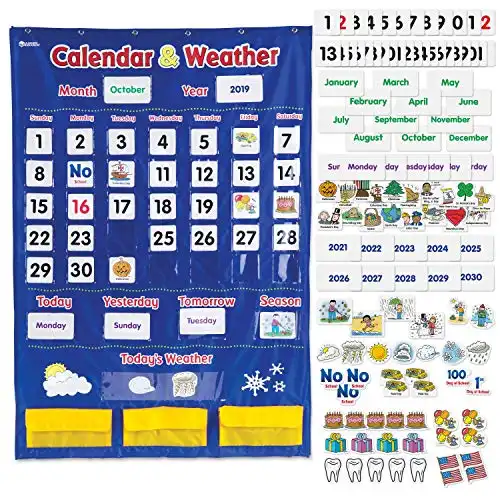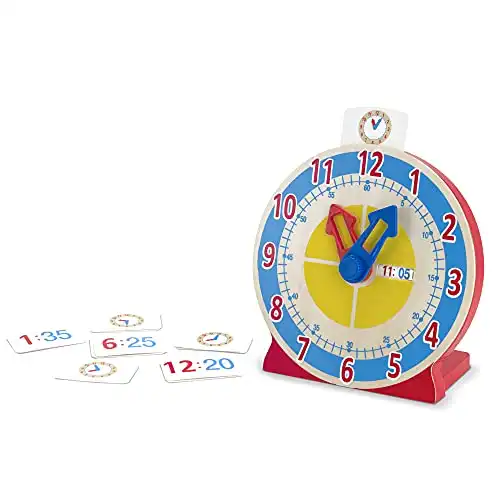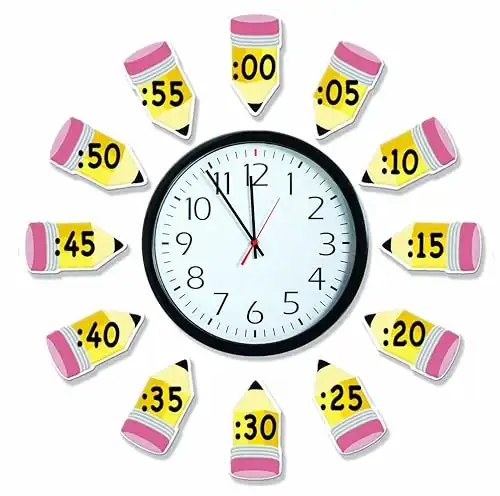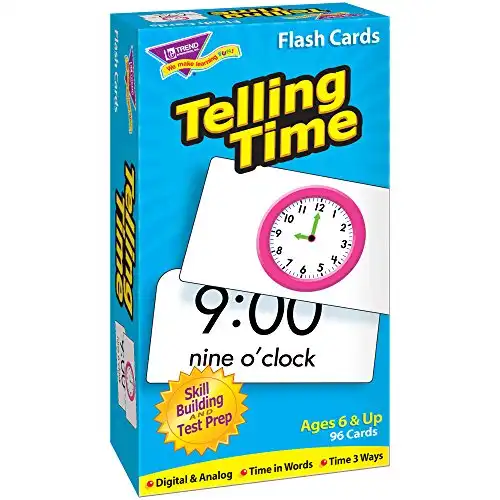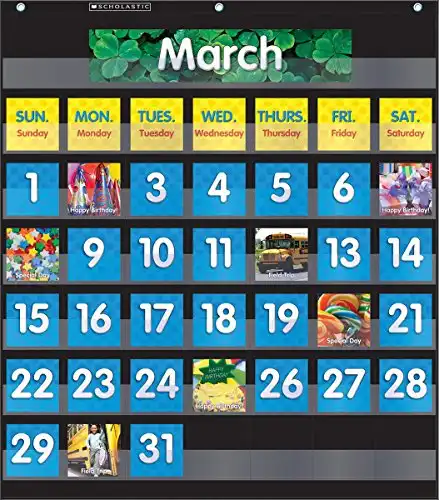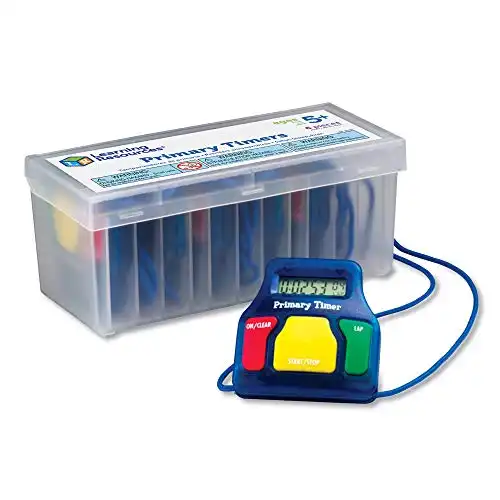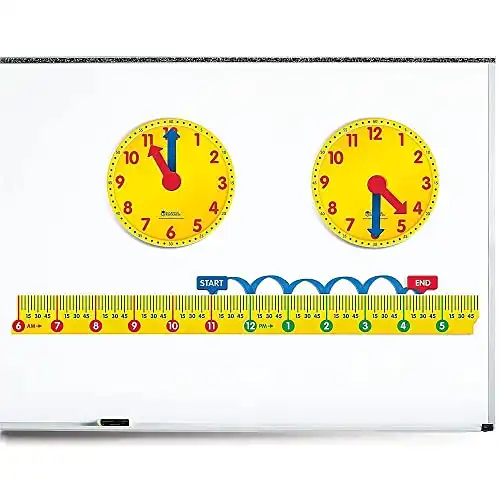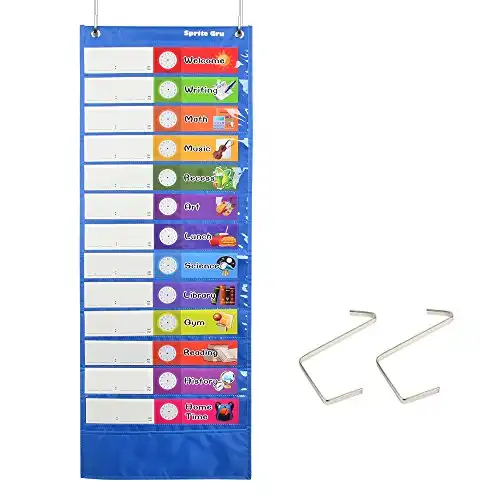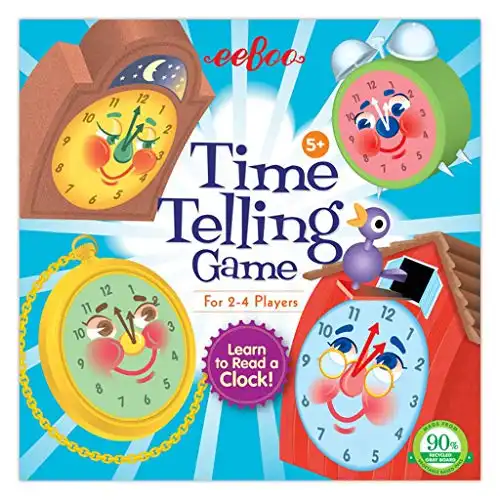These telling time activities will help kids learn to say what time it is within seconds with just a glance at the clock! Try them in your classroom.

Telling Time Activities for the Classroom
Telling time is something many adults do without even thinking. That’s because knowing the time is essential to everyday life. It’s time for your students to learn about time, but where do you start?
Why do you need to teach time to kids? When you introduce this math skill to kids, you need fun and effective activities for helping kids practice as they learn. These telling time activities, books, and resources will do just that, making learning time fun for kids of any age.
Why Is Teaching Kids to Tell Time Important?

Knowing and telling time is an important skill that people use throughout their lives. People use the time to get to work, make plans, schedule appointments, traveling places, cooking meals, and much more. When kids learn about time, they discover a foundational skill that will follow them into adulthood. When you teach the concept of time, it’s essential that your kids:
- understand the concept of time
- know what hours, minutes, and seconds mean
- can tell the time on both digital and analog clocks
Telling Time Activities by Grade

Make sure your telling time activities are fun, exciting, and (most important) age-appropriate. Learning time is a huge milestone for children.
It can be a little confusing at times, so introduce time in manageable chunks of learning that have a natural progression. For example, after learning time to the nearest hour in kindergarten, kids will be ready to break that down into smaller time chunks in 1st grade by learning the half-hour. In second grade, time can be broken down even further, with kids learning time the quarter hour and to the nearest minute. Here are some excellent telling time activities that are organized by the grade-level!
- Kindergarten – In kindergarten, teach kids to tell time to the nearest hour, as well as time vocabulary words. Use time of the day picture sorts, clock clip cards, designing a watch, and other hands-on activities to teach.
- First Grade – Get ready to learn even more in first grade! Teach time by the hour and half-hour with fun activities, such as a clock puzzle, an hour “scoot” game, or a time picture sort.
- Second Grade – This grade level gets even harder, but with the right foundation, kids will quickly catch on! Try teaching how to tell time to the nearest minute or 5 minutes with fun activities, games, and puzzles!
Telling Time Activities for Any Grade Level
There are so many more telling time activities. Kids need a lot of practice to master this vital skill, so no matter what grade they’re in, give kids plenty of hands-on practice. When activities are hands-on, kids engage during the learning process, which helps them master the skill faster. Check out the ones below and try a few of the quick, fun ones shared by Scholastic!
Teaching the Passage of Time
- Daily Schedules – Write down the actual time as you get to specific points on the daily schedules so kids can get a feel for how long a day is.
- Time Card Sort – Using pictures of events and actions, allow students to sort them into categories depending on how long they take (such as minutes, hours, days, etc.).
- Duration Contests – Have kids compete to see who can do something the longest. For example, have students hop on one foot and see who can go the longest. This activity helps to develop the concept of the passage of time.
- Timelines – For a more general concept of the passage of time, let students bring in pictures of themselves at different points in their lives and have them place the photos on a timeline. The kids will be able to see how they have changed over time.
- Elapsed Time – Help students develop a concept of how much time a minute is by having them put their heads down on the desk. Tell them to stay like that until they think a minute is passed and then raise their heads. See who gets closest to an actual minute.
Teaching the Parts of the Clock (Analog & Digital)
- Get Craftsy! – Kids can make a moveable parts clock with paper and a brass pin. Have kids cut out a circle for the face of the clock, two rectangles to represent the hour and minute hand, and pin together for a practice clock. You could also provide the pieces to the clock for kids to put back in the correct spaces.
- Playdough Mats – If you have a clock practice mat, give kids fun ways to represent time. They can roll play-dough into clock hands or even use pieces of candy such as a candy cane at Christmas-time or a lollipop any time of year.
- Puzzles – A telling time printable puzzle will give kids plenty of practice matching the time on an analog clock with a digital clock!
Telling Time to the Hour, Half-hour, Quarter-hour, and Minute
- Review Mats – Learning to tell time is all about the practice. Find fun math practice worksheets to give kids the practice they need to master time in addition to reviewing other skills throughout the year!
- Clothespin labels – Using a practice clock, such as the popular Judy clock (or a simple printable clock), have kids practice telling time by writing a specific time on a clothespin. Kids can then click the pin onto the clock that displays that time.
- Large Clock Manipulative – Use a print-out of a large clock, and have students label the numbers and cut out clock hands. Giving them prompts, have them manipulate the clock to show the correct time.
- Sidewalk Chalk Clock – Draw a giant sidewalk chalk clock on the ground outside. Use sticks or similar objects. Give the child a time and let them create it on the giant clock!
Teaching How to Write Time to the Hour, Half-hour, Quarter-hour, and Minute
- Plastic Easter eggs – Another great telling time activity is made by reusing plastic Easter eggs. Write the time on one half of a plastic egg and represent that same time in another way (clock, written time, etc.) on the other side of the egg. Kids will need to match the eggs together with the correct time matches.
- Time BINGO – A time is announced using a specific format (es: half-past 7), and the students must identify the correct time on their game board (ex: 7:30)
- Matching cards – Use cards with different ways to write times and have the students match them. Puzzles are a fun way to practice matching different representations of time.
Teaching the Calendar (Days, Months, Seasons)
- Order the Days – Write the seven days of the week on a large piece of paper or dry erase board. Hand them out in random order, and then have the students holding them to put themselves in order.
- Days of the Week Song – There are several variations of songs for the days of the week. Pick your favorite, and sing it with the students to help them memorize the order. One favorite of mine is singing it to the tune of the Addams Family theme song.
- Colorful Month Chains – give the students strips of paper with the months of the year on them (or let them write themselves). Then they staple or tape them in rings to make paper chains that represent the whole year.
- Season Card Sort – This time, using pictures of events and actions, have students sort them into season categories.
- Class Calendar – Keep a calendar in the room where kids can view or even add their pictures or stickers that represent seasons and holidays.
Telling Time Books

Books foster a love of reading, of course, but they are also used to teach math skills! These telling time books will introduce important time concepts to kids, including vocabulary. Kids will learn about how time is important and what different times of the day mean. These telling time books will get kids excited about clocks and time!
- T is for Time by Roland Smith – This ABC book uses time concepts and vocabulary for each letter of the alphabet. It is a great book to introduce the topic.
- Dinosaur Tells the Time by Jan Lewis – This is a book that teaches kids time while encouraging them to move the hands on the clock as they read.
- Telling Time by Jules Older- If you’re looking for a great way to teach kids the difference between an analog and digital clock, then consider reading this book to them. It does a great job of showing kids how to read each clock type.
- Bats Around the Clock by Kathi Applet – These bats in this book dance around the clock, teaching kids about time and dance moves! Kids will have a blast learning time with this story.
- The Clock Struck One by Trudy Harris – Styled after the nursery rhyme Hickory Dickory Dock; this story introduces time by the hour. A cat chases a mouse throughout the day.
- Telling Time with Big Mama Cat by Dan Harper – is a hands-on way to learn time! Not only do kids get to read about time, but they learn important vocabulary. They also get to use the built-in clock to practice making time!
- What’s the Time, Mr. Wolf? by Annie Kubler – Do you know kids who are hungry all the time? This book will resonate with them! It’s a finger puppet book that teaches time to young children
- Little Hand, Big Hand by Pfiffikus – This book gives kids a lot of practice telling different times of the day. It focuses on helping students understand the difference between the big hand and little hand, an important distinction that kids need to know.
- How to Tell Time: A Lift-the-Flap Guide to Telling Time by DK – This telling time book is an interactive way for kids to learn telling time. Kids will enjoy lifting the flaps to learn something new about time. For example, they review how long it should take to brush your teeth to the difference between AM and PM.
- Wipe Clean Telling the Time by Jessica Greenwell – Looking for an interactive book that will help kids learn time? This wipe-clean book is the answer! Kids will get to use a dry erase marker to solve the time on each of these fun and interactive pages.
- It’s About Time by Stuart J. Murphy – A helpful book for kids learning to connect what they do each day with the time.
- Me Counting Time by Joan Sweeney – This time book is a great introduction understanding the many measurements of time and how they’re used in everyday life.
- Game Time by Stuart J. Murphy – Teach weeks and hours with this relatable book for kids.
- 10 Minutes Till Bedtime by Peggy Rathmann
- What Time is It, Mr. Crocodile? by Judy Sierra
Are you looking for even more telling time activities for kids? Here are some great videos (and more books) for teaching time like a boss!
Resources for Telling Time
The activities seen in this post are available in various resources found on Teachers Pay Teachers. Click the images above to visit the unit that has the activity seen in the photo. Find out why teachers love the Mindful Math program for Kindergarten, first grade, and second grade.
Kindergarten Measurement & Time Unit
First Grade Measurement & Time Unit
Second Grade Measurement & Time Unit
FREE Telling Time Activity
Grab your free copy of the time matching puzzles by clicking the image below and signing up!
Free Daily Practice Math Mats
Get students to practice not only their time skills but other skills as well. These math mats are the perfect daily review practice.
Telling Time Materials
- Board Games & File Folder Games – Playing games while learning not only makes learning more memorable, it’s also… well, FUN! Board games and file folder games help kids practice time in a fun and memorable way.
- Pocket Chart & Bulletin Board Materials – Do you have a pocket chart or bulletin board that lists your daily schedule? If not, it’s time to make room for one! Seeing time around the classroom and making it a part of everyday life helps kids become more familiar with telling time, which also helps teach time vocabulary words.
- Flashcards – Flashcards allow kids to practice identifying time quickly. If you have two sets of flashcards, use both sets in a matching game!
- Wall Clock – There’s something to be said for having a telling time clock on the wall. When students ask what time they’re going to the gym or lunch, tell them what time you typically go. Then, have them look at the clock to figure out how soon they’ll leave the classroom for that activity.
- The Student! – A kid’s body makes a great teaching tool for telling time. It’s important to involve kids in the learning process. Give their bodies something to do instead of just sitting at a desk. Call out a specific time and have students move around the room or around a clock rug to represent that time.
- Printables – Printables are a powerful teaching tool. With printables, kids can practice what they’ve learned about time, such as matching times to clock faces.
- Apps & Online Games – There are many apps and online games that can be useful for teaching time. These programs allow kids to practice time in a fun way so that they are excited to learn.
- Blocks & Legos – Matching written time with clock faces is one way for kids to practice this critical skill. You can use blocks or legos with the time written or taped to it, giving kids a hands-on way to match time!
- Clock Manipulative – Kids need to be able to manipulate a clock to show what they’re learning. There are gear clocks and magnetic clocks that you can purchase for your classroom, or you can have students make a clock using a printable and brass pins. Kids can then move the hands on the clock to show a specific time.
- Stopwatch or Timer – Part of learning time is knowing how to measure it. Kids can use a stopwatch or a timer to measure an activity. This method will get them in the mode of thinking time as the seconds and minutes tick away.
More About Teaching Math
Teach Telling Time with Books and Videos
Teaching Measurement with Books and Videos
Hands-On Learning: Fishing Fun
PIN IT

FREE Number Sense Email Series
Sign up for the building number sense email series filled with effective strategies, must try activities, and FREE resources to build routines in your classroom. Everything you need to help kids grow their number sense and have fun at the same time!











